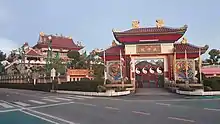
Viharn Sien or Viharnra Sien,[lower-alpha 1] officially known as Anek Kusala Sala,[lower-alpha 2][lower-alpha 3] is a museum and shrine designed in the style of a royal Chinese temple, located near Wat Yansangwararam in Pattaya, Chonburi.[1] It was developed in 1987 by Thai-Chinese Sa-nga Kulkobkiat on land provided by king Bhumibol Adulyadej to create a building for an art collection gifted to the Chakri dynasty.[2][3]
Etymology and definition
Viharn, for Thai people commonly Vihan translates from Thai: วิหาร sanctuary or chapel. Sien translates from Thai: เซียน great master or deity. Viharn Sien often called Wihan Sien[4] has evolved from Sanskrit Vihara or Vihāra, generally refers to a place of speech or monastery which has various rooms and/or living quarters for monks or nuns.,[5][6] see also Etymology and nomenclature. Anek Kuson Sala is the name given by King Bhumibol. Adulyadej.[7]
Buildings and exhibition
The main building at Viharn Sien is a three-story structure in the finest Chinese architecture style with decorative arts and exhibition spaces, built in 1987 to mark the 60th anniversary of the King.[8] Near the entrance is a paved courtyard with a collection of bronze statues, trees, plants and flowers, as well as a monument of Sa-nga Kulkobkiat, who was born in Bangkok on October 18, 1925, but raised in China.[9] Among the many drums, bells, Buddha statues, and other cultural artifacts are replicas of the Terracotta Army archaeological site.[10] The main building houses a significant collection of bronze statues, Shaolin monks, jade carvings, paintings and pieces of Thai and Chinese art, and cultural relics on three levels.[11]
Nearby places
Notes
References
- ↑ Australian-New Zealand Women's Group (2005). Bangkok Guide. ISBN 9789749309544. Retrieved 17 May 2021.
- ↑ Anita Isalska, Tim Bewer, Celeste Brash, Austin Bush, David Eimer, Damian Harper, Andy (2018). Lonely Planet Thailand. ISBN 9781787019263. Retrieved 17 May 2021.
{{cite book}}: CS1 maint: multiple names: authors list (link) - ↑ Justin Thomas McDaniel (2017). "Architects of Buddhist Leisure - Page 117 (102-Chapter2)" (PDF). Retrieved 17 May 2021.
- ↑ Justin Thomas McDaniel (2017). Architects of Buddhist Leisure. ISBN 9780824876753. Retrieved 17 May 2021.
- ↑ Monier Monier Williams, Sanskrit-English Dictionary Etymologically Arranged, Oxford University Press, p. 1003. "Vihāra". Retrieved 17 May 2021.
{{cite web}}: CS1 maint: multiple names: authors list (link) CS1 maint: numeric names: authors list (link) - ↑ Paul Dundas (2003). The Jains. Routledge. pp. 203–204. ISBN 1-134-50165-X. Retrieved 17 May 2021.
- ↑ "Anek Kuson Sala". Government Chonburi, section Tourism and Sports Office. Retrieved 17 May 2021.
- ↑ T. Turner (2016). "Thailand Travel Guide 2021: Must-see attractions". Retrieved 17 May 2021.
- ↑ "Viharn Sien Chinese Temple – Part 2". Pattaya: New Pattaya. 25 December 2012. Archived from the original on 12 February 2020. Retrieved 17 May 2021.
- ↑ "Viharn Sien Chinese Temple – Anek Kusala Sala". Pattaya: New Pattaya. 23 December 2012. Archived from the original on 12 February 2020. Retrieved 17 May 2021.
- ↑ "Viharnra Sien (Anek Kusala Sala) – Chinese Temple In Pattaya". Pattaya Sanook. 16 March 2021. Retrieved 17 May 2021.